沪教牛津版 深圳小学英语四年级U4 are you happy
沪教牛津版小学英语三起点四年级上册Unit 3 Are you happy知识点总结教案
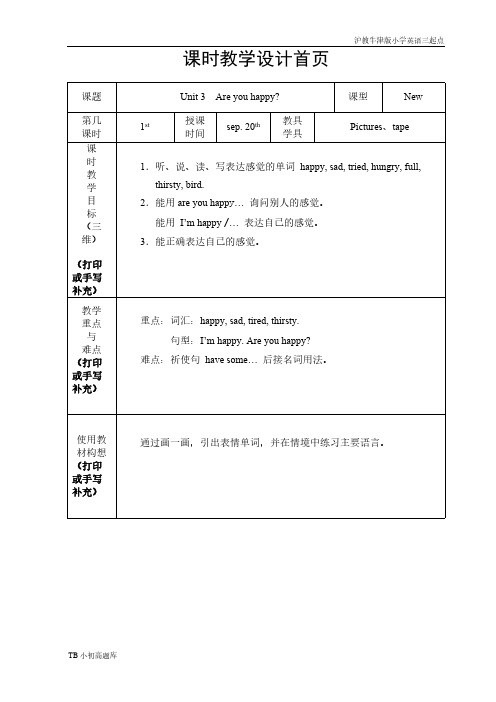
Ⅰ、Warm-up
1.Listen to the song. ‘Are you happy’
2.Explain ‘happy’
(smile happily and Point to the face) I’m happy.
Ⅱ、Presentation
1.Learn the words: happy, sad, thirsty, hungry, full, He is happy.
课题
第几 课时 课 时 教 学 目 标 (三 维)
(打印 或手写 补充)
教学 重点 与 难点 (打印 或手写 补充)
课时教学设计首页
沪教牛津版小学英语三起点
Unit 3 Are you happy?
1st
授课
sep. 20th
教具
时间
学具
课型
New
Pictures、tape
1.听、说、读、写表达感觉的单词 happy, sad, tried, hungry, full, thirsty, bird.
2nd
授课
sep. 23th
教具
时间
学具
沪教牛津版小学英语三起点
课型
New
tape
了解 e 在单词中的发音,听、说、读、写单词 bird, see, drink 在情境中理解,并简单讲叙小故事<A thirsty bird> 通过学习任务,帮助学生巩固,综合运用本单元知识。
重点:了解字母 e 在开音节单词中的发音。 难点:祈使句 Have some… 后接名词用法。
2.Copy the words in P11
达标反馈:
课后拓展性作业 Can talk about feelings.
M1U3Areyouhappy(课件)-四年级英语上册(沪教牛津版深圳)

2. Pete we 4. Chinese red 6. Pete Eve
选出下列每组单词中画线部分读音不同的一项。
( )1. A. she
B. me C. egg
( )2. A. dad
B. plate C. jam
( )3. A. write B. name C. elephant
( )4. A. sad
The bottle is __ta_lland ___t_h_in. The bird cannot drink the water.
The bird can see little stones.
Fill in the blanks
Look! The bottle can drink the water now. He is _h_a_p_p_y_.
Read and choose
( A ) 1. —I’m thirsty. — Please ______.
A. have some water B. sing a song C. sit down
( A ) 2. This is Sally. ______ is thirsty.
A. She
B. He
【例句】The crow is thirsty and tired. 乌鸦又渴又累。 【常见词组】 be tired of 厌烦
Vocabulary
thirsty
I’m thirsty. I want to drink some water.
Vocabulary
I’m tired. I need to have a rest.
Ben: _I_’_m__fu_l_l_n_o_w_._______ Kitty: A__re__y_o_u_t_h_ir_s_ty_,_B_e_n_?__
牛津上海版(深圳用)四年级英语上册Unit4、Do,you,have,any,cousins课件2

parents
father (David)
mother (Linda)
Uncle (John)
Байду номын сангаасaunt (Lily)
me (Jill)
cousin (Dan)
Who is mother? WWhohsoesemuontchleerisisJLoihnnd?a?
Oxford English
4
Module 2 MMyofadmuillye, m2y friends and me My family, my friends and me
Do you have any cousins?
Period 1
Family tree
Learn the sounds.
pens ten red
LinJodhanisisJiJlill’ls’smuontchle.r.
Uncle (John)
Aunt (Lily)
Cousin (Dan)
This is my ... His/Her name is ...
Golden eyes parents mother aunt daughter
father brother cousin
Let me show you my family photo. And try to match their photos.
Who are they?
My mother married my father, David. They have a daughter. That’s me. I’m Jill.
沪教牛津版(深圳用)英语四年级上册Unit 4 Do you have any cousins 课件

siblings parents grandparents children cousins
Jill’s family tree
Dan’s family tree
Do you have any _____s?
Yes, I have one ______. Yes, I have some _____s. No, I don’t have any _____s.
1
2
3
The right order
4
5
2
1
4
3
5
Hi, Kitty. Welcome to my home.
外公
grandfather
外婆
grandmother
爷爷
grandfather
奶奶
grandmother
Uncle John
舅舅
Aunt Lily
舅母
Cousin Dan
表弟
Uncle David
姑父
Aunt Linda
姑姑
Cousin Jill
表姐
Hello, I’m Jill. This is my family tree. I have a ____ family. There are ____ people in my family. Look! They are my ______s. They are my ______s. They are my uncle and ____. And this is my _____. His name’s ____. He’s Uncle ____’s son.
小学英语沪教版四年级上册《3Are you happy》省级名师优质课教案比赛获奖教案示范课教案公开课教案
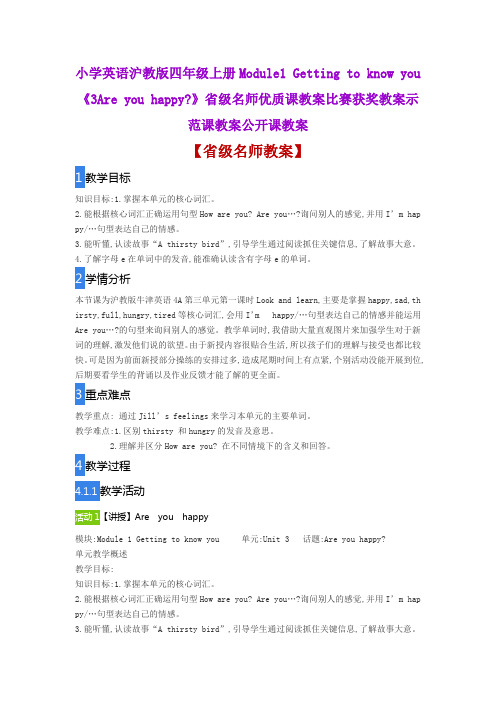
小学英语沪教版四年级上册Module1 Getting to know you 《3Are you happy?》省级名师优质课教案比赛获奖教案示范课教案公开课教案【省级名师教案】1教学目标知识目标:1.掌握本单元的核心词汇。
2.能根据核心词汇正确运用句型How are you? Are you…?询问别人的感觉,并用I’m hap py/…句型表达自己的情感。
3.能听懂,认读故事“A thirsty bird”,引导学生通过阅读抓住关键信息,了解故事大意。
4.了解字母e在单词中的发音,能准确认读含有字母e的单词。
2学情分析本节课为沪教版牛津英语4A第三单元第一课时Look and learn,主要是掌握happy,sad,th irsty,full,hungry,tired等核心词汇,会用I’m happy/…句型表达自己的情感并能运用Are you…?的句型来询问别人的感觉。
教学单词时,我借助大量直观图片来加强学生对于新词的理解,激发他们说的欲望。
由于新授内容很贴合生活,所以孩子们的理解与接受也都比较快。
可是因为前面新授部分操练的安排过多,造成尾期时间上有点紧,个别活动没能开展到位,后期要看学生的背诵以及作业反馈才能了解的更全面。
3重点难点教学重点: 通过Jill’s feelings来学习本单元的主要单词。
教学难点:1.区别thirsty 和hungry的发音及意思。
2.理解并区分How are you? 在不同情境下的含义和回答。
4教学过程教学活动1【讲授】Are you happy模块:Module 1 Getting to know you 单元:Unit 3 话题:Are you happy?单元教学概述教学目标:知识目标:1.掌握本单元的核心词汇。
2.能根据核心词汇正确运用句型How are you? Are you…?询问别人的感觉,并用I’m hap py/…句型表达自己的情感。
Unit3Areyouhappy?(教案)沪教牛津版(深圳用)英语四年级上册

Unit 3 Are you happy 教学设计教学目标1. 认知目标:四会本单元的核心单词happy, sad, hungry, thirsty, full ,tired和拓展词汇surprised。
2. 能力目标:通过寓言故事的学习和各种游戏活动的组织,让学生能够运用所学的句型I a m… /I feel…进行交流,培养学生的交际能力、合作能力和运用能力。
3. 情感目标:采用寓教于乐的教学,让学生能把所学的内容与实践生活结合起来,在生活中学习英语、使用英语,达到学以致用的目的。
学情分析四年级学生仍有着极强的求知欲,学习积极主动,喜欢直观形象思维大于抽象思维,对新事物充满好奇。
他们的英语知识储备已有三年,具有了一定的自主学习能力,但还存在着学习方法和学习策略经验不足等问题。
同时有少部分学生对英语学习提不起兴趣。
因此在设计本课时,教师利用寓言故事《乌鸦喝水》来呈现主要句式和词汇,更充分的帮助学生在语境中理解语言,并借助现代教育技术激发学生的学习兴趣,满足个体的学习需求,提高学生综合语用能力。
重点难点教学重点:1.能运用词汇happy, sad, hungry, thirsty, full, tired, surprised交流情绪、感受等。
2.能运用句型I am…/ I feel…来表达自己的情绪体验。
3.理解故事情节和内容,接触、理解语言,体验语言在实际中的运用,享受故事带来的乐趣。
教学难点:学生之间能相互配合,完整地表演故事。
教学过程1. 认知目标:四会本单元的核心单词happy, sad, hungry, thirsty, full ,tired和拓展词汇surpr ised。
2. 能力目标:通过寓言故事的学习和各种游戏活动的组织,让学生能够运用所学的句型I a m… /I feel…进行交流,培养学生的交际能力、合作能力和运用能力。
3. 情感目标:采用寓教于乐的教学,让学生能把所学的内容与实践生活结合起来,在生活中学习英语、使用英语,达到学以致用的目的。
牛津上海版(深圳)四上Unit 3《Are you happy》(第2课时)教案
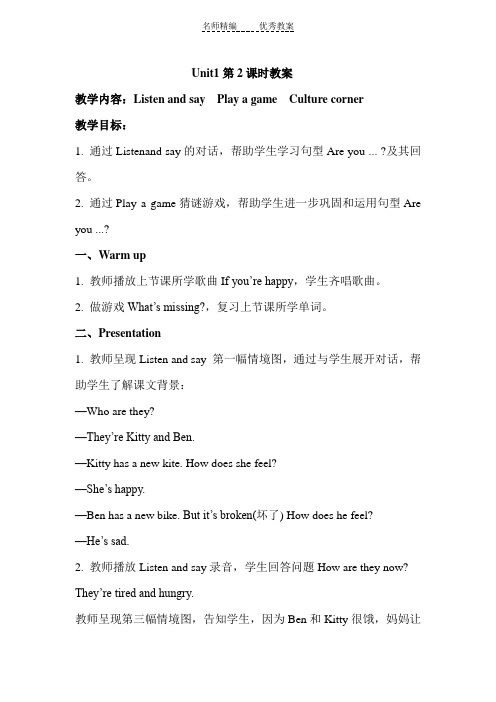
Unit1第2课时教案教学内容:Listen and say Play a game Culture corner教学目标:1. 通过Listenand say的对话,帮助学生学习句型Are you ... ?及其回答。
2. 通过Play a game猜谜游戏,帮助学生进一步巩固和运用句型Are you ...?一、Warm up1. 教师播放上节课所学歌曲I f you’re happy,学生齐唱歌曲。
2. 做游戏What’s missing?,复习上节课所学单词。
二、Presentation1. 教师呈现Listen and say 第一幅情境图,通过与学生展开对话,帮助学生了解课文背景:—Who are they?—They’re Kitty and Ben.—Kitty has a new kite. How does she feel?—She’s happy.—Ben has a new bike. But it’s broken(坏了) How does he feel?—He’s sad.2. 教师播放Listen and say录音,学生回答问题How are they now? They’re tired and hungry.教师呈现第三幅情境图,告知学生,因为Ben和Kitty很饿,妈妈让他们吃了饼干。
Have some biscuits是吃饼干的意思。
3. 教师播放Listen and say动画,学生回答问题How does Ben feel now?He’s full and thirsty.教师呈现第三幅情境图,让学生了解Ben目前的感觉。
三、Practice1. Role play在小组内,扮演对话中人物,练习对话。
小组练习后,上台表演PK。
2. 教师把本部分图片打乱,请学生把图片按照正确的顺序放置。
3. Fill in the blanks:教师呈现各部分图片及内容,空出重点句子,学生填空。
英语四年级上册Unit3Areyouhappy-教案-沪教牛津版(深圳用)

英语四年级上册Unit3Areyouhappy-教案-沪教牛津版(深圳用)Module 1 Getting to know youUnit 3 Are you happy?教学目标1.能够独立阅读故事。
能够熟练运用本单元所学句型,进行交流。
2.学生欣赏故事《乌鸦喝水》。
通过看图提问、看关键词介绍图片等活动,学生通过阅读,抓住关键词,了解故事大意。
通过学习任务,学生巩固和综合运用本单元所学的知识。
教学重点1. 词汇: bird, see , drink2.句型: The bird is very thirsty .I have a good idea.教学难点阅读故事,抓住关键信息,了解故事大意。
教具准备幻灯片教学过程一、导入新课(一) Sing a song<>复习已经学过的感觉单词。
创设情境,世界各国都在倡导爱读书活动,学校内也举行相关图书活动,以此来询问学生喜欢看的书籍。
引出本课伊索寓言故事中的乌鸦喝水。
(二)出示乌鸦图片,让学生观察乌鸦的特点,让学生明白乌鸦可以怎样来喝水?出示一个细长的玻璃瓶,引导学生观察它的特征,在观察的过程中告诉学生The bottle is tall and thin .二、讲授新课(一)在没有熟知本课内容前,通过听音锻炼孩子们的听力,并能初步了解故事大概内容。
之后进行设疑自探,让学生自己提出问题,其他学生解决问题。
提高学生自主动脑学习能力。
(二)由于语言的限制,学生们只能提出简单问题。
老师提出更深层次问题,让学生进行再次探究,加深对故事的理解。
(三)出示原文图片,一张一张展示给学生观察,通过观察图片,用自己的理解来讲述图片内容,锻炼学生思维,之后给出相应答案。
(以填空内容为主,通过课文把故事主要内容联系到一起),在此基础上每完成一张图片,都会让学生来假设,如果你是此时的乌鸦,你会说些什么话?激发学生的学习热情,也为孩子的分析能力打下基础。
(四)watch<>,学习书上原课文给学生时间,练习熟读课文,之后讨论how to retell the story.(五)role play活动小组讨论环节,分角色,表演故事内容(旁白与乌鸦)(六)给学生讲解本课故事的寓意,让学生联系实际,并能真正的做到善于思考。
新沪教牛津版四年级上Unit 3 Are you happy教案
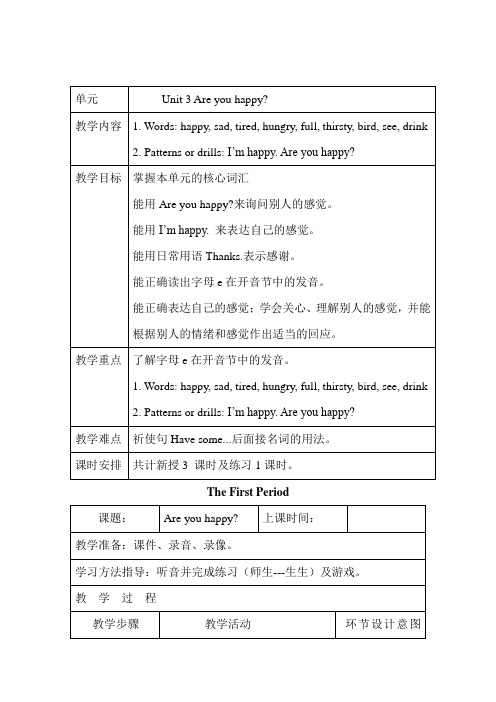
The First PeriodThe Second PeriodThe Third PeriodThe Fourth PeriodUnit 5 Animals in dangerTeaching Aims(教学目标):1.能听、说、读、写本课的核心词汇:thousand, hundred, wild, way, die, learn, send, in danger, in the past, take care of2.能熟练掌握核心句型:In the past, there were many pandas.What can we do to help them?3.知道动物是人类的朋友,人类应该和动物建立良好的关系,要保护动物。
Teaching Importances and Difficulties (教学重难点):1.能在语境中正确运用本单元的核心词汇。
2.用There was/were …对某种东西的数量进行陈述。
3.了解字母u及字母组合ue、oo在单词中的发音规律,拼读简单的单词。
Teaching Tools(教学用具):录音机、自制课件、照片等Teaching Procedures(教学过程):StepⅠ. Warm up and revision(热身与复习)1. Sing a song.2. Play a game: Apple tree3. Count the numbers together.Step Ⅱ. Presentation and practice (自主探究)1. 生词关T: Please write the meanings on your paperthousand______ hundred______ wild________only________ about______ whale _________am/is_______(过去式) are______(过去式)2. T:Show the pictures and learn the new words: thousand, hundredSs:Read these words after teacher.3. Work in groups to read the new words. Recite the new words, then recite in groups。
沪教牛津版四年级上册英语全册教案(含单元知识点总结)
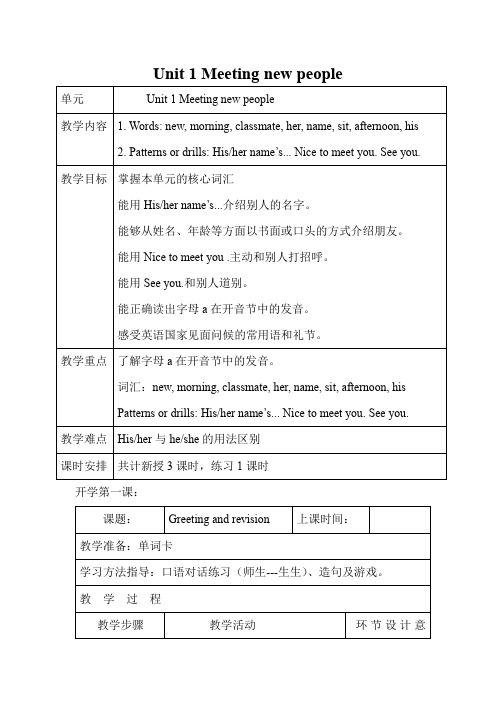
教学难点
His/her与he/she的用法区别
课时安排
共计新授3课时,练习1课时
开学第一课:
课题:
Greeting and revision
上课时间:
教学准备:单词卡
学习方法指导:口语对话练习(师生---生生)、造句及游戏。
His name’s...
Her name’s...
See you.
课后小记
The Third Period
课题:
Meeting new people
上课时间:
教学准备:课件、录音、录像。
学习方法指导:听音并完成练习(师生---生生)及游戏。
教学过程
教学步骤
教学活动
环节设计意图及效果分析
Step 1 Greeting
Ss: Nice to see you too.
T: How are you?
Ss: I’m fine,thank you. And you?
T: I’m very well.
T: What’s the weather like today?
Ss: It’s...
T: What day is it today?
教学内容
1. Words:new, morning, classmate, her, name, sit, afternoon, his
2. Patterns or drills:His/her name’s... Nice to meet you.See you.
教学目标
掌握本单元的核心词汇
牛津沪教版四上英语Unit 3 Are you happy 教案

Module 1 Unit 3 教案2一、教学重点句型:I’m happy.Are you thirsty, Ben?日常用语:Thanks二、教学栏目Listen and say, Play a game三、教学目标1. 通过Listen and say对话,帮助学生学习句型Are you ...(adj.)?及其回答。
2. 通过Play a game猜谜游戏,帮助学生进一步巩固和运用句型Are you ...?四、教学步骤Pre-task preparations1.出示表示各种感觉的单词卡片,如thirsty,happy,sad,full,hungry,请学生看图说出人物的感觉,复习表示感觉的单词。
接着,教师再说各种情景,要求学生根据情景快速接龙,注意学生接的句子要和前一句有关联。
T: You have a new bicycle.S1: I have a new bicycle. I’m happy.T: I want some water.S2: You want some water. You are thirsty.或给出情景,让学生回答问题。
T:(show a picture of a new bag)You have a new bag. Are you happy?S: Yes. I have a new bag. I’m happy.2.学生根据教师的指令做Quick response活动,教师一边发指令一边和学生一起做动作。
T: Run, run, run very fast. Jump, jump, jump high. Swim, swim, swim very well. Climb, climb,climb trees.Ss: (do the actions)学生跟着教师做好动作后,教师说I’m tired. Are you tired?,然后把句型写在黑板上。
While-task procedures1.在黑板上写出核心句型I’m happy. Are you happy?,让学生跟读数遍。
牛津上海版(深圳)四年级上册Unit 3《Are you happy》ppt课件
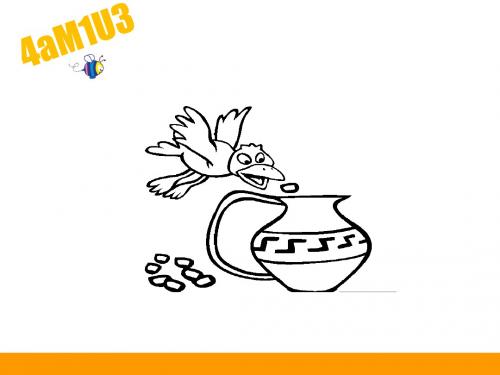
I
!
It is hot. A crow cannot find any water. He is very thirsty, and wants to give up. But he says to himself, “Go, go, Mr Crow! You are so lucky, don’t you know?” The crow keeps flying.
More about the story:
Then, he sees a pitcher. “Aha! Water!” The pitcher is tall and thin. The crow cannot drink the water. He is very sad, and wants to give up. But he says to himself, “Go, go, Mr Crow! You are so clever, don’t you know?” The crow keeps thinking.
crow
I am a little crow, black and clever.
I like singing and flying.
crow
Are you hungry, hungry, hungry,
Mr Crow? …,…
The Crow and the Pitcher
The Crow and the Pitcher
A It is hot. A crow is very thirsty.
B But he cannot drink it.
He sees some water in
C
the pitcher.
At last, the crow can D drink the water. He is
英语四年级上册 Unit 3 Are you happy-教案-沪教牛津版(深圳用)
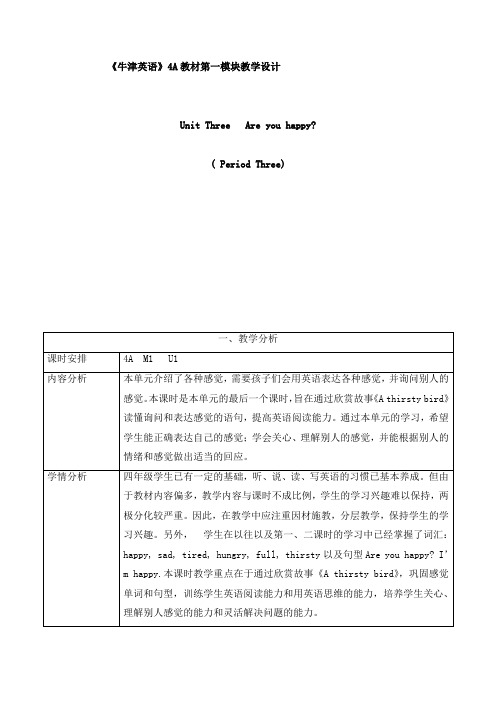
《牛津英语》4A教材第一模块教学设计Unit Three Are you happy?( Period Three)大胆实践,积极参与,共同合作与交流,帮助学生在任务型的教学途径下发展综合语言运用能力,使语言学习的过程成为学生形成积极的情感态度、主动思维和大胆实践、提高跨文化意识和形成自主学习能力的过程。
因此,在本课的教学中主要采取任务型教学模式和听说法等。
另外,在本节课中还将采用多媒体技术,因为多媒体技术的运用可以打破时间和空间的局限,激发学生学习英语的兴趣,体会英语学习的乐趣。
为英语语言学习创设情境氛围,开拓学生的视野。
课堂预设本节课上100%学生能能懂会说小故事。
80%学生能会运用所学词汇和句型表达思想,掌握基本阅读方法。
30%学生能灵活运用阅读方法,阅读欣赏难度相似的故事。
20%能编写相应难度的小故事。
三、教学准备教学资源课本、动画片段教/学具图片(连环画),自制ppt课件板书设计Unit 3 A thirsty bird四、教学过程教学环节媒体使用教师活动学生活动设计思路及分析Warm-up 1 播放Areyouhappy?动画歌曲。
搜索网上与课堂教学内容相关的资源,丰富课堂教学。
播放Are you happy?歌曲。
跟唱Areyouhappy?通过唱歌曲,一方面可以活跃课堂气氛,另一方面可以复习所学情绪词和句型:Are you …?Presentation 1出示图片,让学生根据图片提供的情境回答问题根据图片提问:1. How is the bird?2. how is the man?根据图片回答问题通过图片展示,创设情境。
2运用媒体,加入chant节奏,活跃课堂气氛,激发学生兴趣。
呈现chant 学唱chant.将单词内容变成chant让学生跟唱,让学生在轻松愉快的氛围中复习所学知识。
同时,最后一句中的Thirsty,thirsty, he isthirsty为下一环节A thirsty bird 的学习打下基础。
牛津上海版(深圳)四上Unit 3《Are you happy》

More about the story:
One by one, he ... Little by little,…. “…”He is ...
More about the story:
Learn from the story:
What do you think of the crow? I think the crow is… What do you learn from the story? I learn …
A
It is hot. A crow is very thirsty. But he cannot drink it.
B
C
He sees some water in the pitcher.
At last, the crow can drink the water. He is happy.
D
E
Then he has a good idea.
More about the story:
Then, he sees some little stones. “Aha! I have a good idea!” The crow picks up the stones and drops them into the pitcher. But he still cannot drink the water. He is very tired, but he says to himself, “Go, go, Mr Crow! You are the best, don’t you know?” The crow keeps trying.
More about the story:
Then, he sees... “Aha! …!” The pitcher is... The crow cannot... He is … , and wants to... But he says to himself, “…! … , don’t you know?” The crow keeps …
最新沪教版小学英语四年级上册《Areyouhappy》公开课教学设计

最新沪教版小学英语四年级上册《Areyouhappy》公开课教学设计《Are you happy?》教案Topic :Are you happy ?Objectives:happy sad hungry full thirsty tiredStructures:I’m happy.“Are you ha ppy?Yes, I am. / No, I’m not.”Teaching Aids :word cards computerProcedure:1)GreetingT: Good morning, boys and girls.S: Good morning,Miss Yao.2) Warm up & RevisionEnjoy a songif you are happy.3) Presentation1. IntroduceToday, there are many teachers in our classroom, so, I feel very happy. Are you happy? (导入)2.New lesson:(授新)T:(show the picture of a boy who is smiling )The boy is smiling. He is happy.(Point to the girl is crying) Is the girl happy?Ss: No, she isn’t.T: No, she’s not happy. She’s sad. S-A-D, sad.Why is she sad? Maybe……She is hungry.……Pupils listen to the radio and read after the tape.The same method granted remaining three words of the new. Activity: boys & girls 、 group 1 &group 2 、two times、one by one 大小声吹气球闪卡(操练)3. SentencesI have a new ball. I’m ____.Are you happy?I play my new basketball. I’m ____.Are you tired?I eat two cakes. I’m ____.Are you full?I can’t write. I’m ____.Are you sad?I want a big cake. I’m _____.Are you hungry?I want some water. I’m _____.Are you thirsty?4. Homework1. Tell your parents your feelings.2. Copy these words and sentences.5. Blackboard designAre you happy?happy sad hungry full。
- 1、下载文档前请自行甄别文档内容的完整性,平台不提供额外的编辑、内容补充、找答案等附加服务。
- 2、"仅部分预览"的文档,不可在线预览部分如存在完整性等问题,可反馈申请退款(可完整预览的文档不适用该条件!)。
- 3、如文档侵犯您的权益,请联系客服反馈,我们会尽快为您处理(人工客服工作时间:9:00-18:30)。
happy
sad
hungry
full
thirsty
tired
Can you say?
•he •she •Chinese •Pete •Eve
I'm happy. I have a new kite.
• Have some biscuits. • Thanks,Mum.
have 吃 thanks = thank you
• I'm full now. • Are you thirsty,Ben? • Have some water.
have 喝
• How are you? • I am ____________, I ____________.
If you're happy and you know it stomp your feet
If you're happy and you know it wink your right
If you're happy and you know it wink your right
If you're happy and you know it never be afraid to show it
• sad • thirsty • full • hungry
have a new bike don't like rainy days want some water I want to eat
Thank you!
If you're happy and you know it clap your hands
If you're happy and you know it stomp your feet
If you're happy and you know it stomp your feet
If you're happy and you know it never be afraid to show it
Are you happy?
If you're happy and you know it clap your hands
If you're happy and you know it clap your hands
If you're happy and you know it never be afraid to show it
我用am,你用are, is连着它他她。 单数用is,复数要用are。
I'm = I am
I'm not happy. Look at my bike! I'm sad.
含be动词的句子变成否定句,在be动词后面加not。
ቤተ መጻሕፍቲ ባይዱ
• How are you? • we're tired and hungry,Mum.
